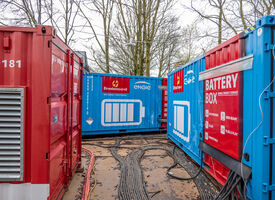What is grid congestion and what can we do about it?
The development of new energy solutions sometimes poses entirely new challenges, for which we have to find a fitting solution before we can move on. Grid congestion, which roughly compares to a traffic jam on the grid, is a typical example of that. We generate more and more wind and solar energy, which is excellent from a green viewpoint, but also creates new challenges for grid operators. The more we use sustainable energy sources, the harder it is to align the supply and demand of our energy. This, however, is crucial for maintaining grid stability, and so we must work together to find fitting solutions to help us navigate through the energy transition.
What is grid congestion?
Grid congestion can best be explained by comparing it to a traffic jam. There is a limit to the amount of cars that can simultaneously use a road. When more cars get onto the road, everyone will have to drive slower and the risk of accidents and traffic jams increases. This problem can be solved by broadening the road by adding more lanes. The way the grid works is somewhat similar. Our demand for electricity increases, but there is a limit to the amount of electricity that the grid can process. We can’t just start generating more power to meet the growing demand. When the grid has reached its maximum capacity, in other words, when there is grid congestion, we need to work on the grid itself.
One way to increase the grid capacity is comparable to the solution for the busy highway. Reinforcing the grid allows it to process more energy. However, grid reinforcement is a costly and time-consuming process which, despite the best efforts of our grid operators, cannot go fast enough to meet the growing power supply and demand. Additionally, the energy transition has changed the way we use the grid in some ways, which comes with new challenges and further complicates solving the congestion issue.

The influence of sustainable energy on the grid capacity
When the grid only delivers electricity obtained from fossil fuels, the situation is usually manageable and grid congestion is less likely to occur. Based on data collected throughout the years it’s fairly easy to estimate the power demand of the connected users. The amount of power generated in advance can also easily be mapped out. This makes it fairly easy to connect supply and demand, much more so than in our current situation.
However, our power demand constantly grows. The amount of electric vehicles increases, we see more and more electric machinery on construction sites and businesses are working hard on becoming more sustainable through electrification (replacing fossil fuels with electricity). We currently find ourselves in a transition phase from fossil fuels to sustainable energy sources, in order to meet the growing power demand as well as climate goals. This energy transition is essential, since fossil fuels will eventually run out and we want to reduce greenhouse gas emissions to reduce global warming. One way to accomplish this is generating electricity from wind and solar energy. However, these sustainable energy sources come with a variety of unique challenges. We can’t predict how much wind there will be on any given day, nor how long and bright the sun will shine. That makes it difficult to adjust the energy supply to the energy demand. This has negative consequences for the grid stability and due to grid congestion it’s not always possible to quickly do something about it.
Unpredictable supply and demand
One of solar power’s main benefits is also one of its main problems in terms of congestion management. For businesses and private individuals the option to purchase solar panels and generate part of their own power is ideal. When they need more power than they can generate they can fall back on the grid. But when the solar panels generate more power than their owner needs, the excesses are disposed of through the grid. This means the grid needs to provide a lot of power during very overcast days and that it must dispose of a lot of power during sunny days.
Through the unpredictability of the weather and thereby the unpredictability of the amount of power that the grid needs to deliver or dispose of, it has become increasingly challenging to maintain a stable grid. This unpredictability only increases since not all owners of solar panels have actually registered their panels with the grid. That makes it very difficult for grid operators to keep track of the amount of solar panels and thus to anticipate to the supply and demand of power.

What are the consequences of grid congestion?
Grid operators are already having a hard time keeping up with the increase in solar panels on the grid owned by private individuals and regular businesses. On top of that, the increasing amount of solar fields requires grid reinforcement. Usually solar fields are set up in the countryside, due to the available space, yet on those locations the grid is particularly unsuited for processing an increased supply of electricity. Reinforcing the grid can take months or even years and is often very costly. Another consequence is that the owners of solar fields sometimes have to wait a long time before they can start generating energy.
Another situation where grid congestion can cause trouble is the expansion of certain production sites. Expanding such locations frequently requires a heavier grid connection, which cannot be realized. If the user profile in such a situation is fluctuating then it might be necessary to find an additional power solution to support the grid.
How are we handling grid congestion?
Solving the problems with our grid capacity requires collaboration between all parties involved, such as the grid operators, but also those who build solar parks, the private individuals and businesses that buy solar panels for personal use or (temporarily) need more power at a (new) location, and parties developing innovative solutions during the energy transition. Energy storage can be one such solution, by temporarily storing excess energy that cannot be disposed of due to grid congestion in batteries. This energy can be released to the grid in a slow and controlled manner at a later moment when the grid capacity allows this.

Working with energy storage systems can be the solution during the construction of solar parks, until the grid connection on site has been sufficiently reinforced. The solar park can immediately start generating energy when this energy can be stored in batteries. The construction of the largest floating solar park in Europe took place with electric tools and machinery wherever possible, and these could immediately be powered with energy from the park’s own solar panels, thanks to the Battery Box.
The Battery Box can both store and release energy. When possible, the Battery Box recharges through the grid. During shortages the Battery Box can then help out by releasing the energy stored inside. When the solar panels generate more energy than the user needs, the Battery Box can store the excesses and release them to the grid in a controlled manner. Slowly feeding excess solar energy back to the grid throughout the day and night prevents grid congestion and allows projects to generate solar energy already without first having the grid reinforced.
Bredenoord helps you find the solution
Do you want to avoid delays during your project caused by the consequences of grid congestion? Then Bredenoord will gladly help you find a temporary power solution that will help you bridge the waiting time for a (larger) connection. We can also help you queries concerning generating additional energy or load management due to redelivery restrictions. Feel free to contact us to discuss the options for your project.





-c01f2eed9f.svg)



